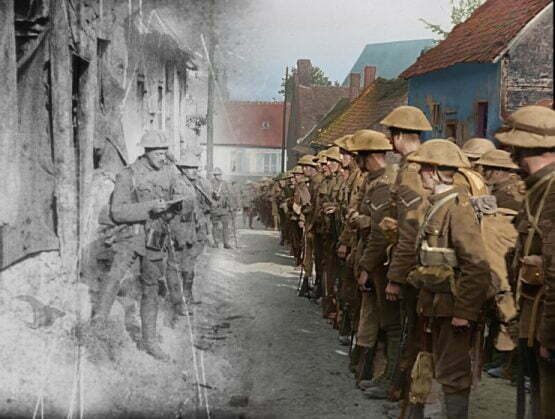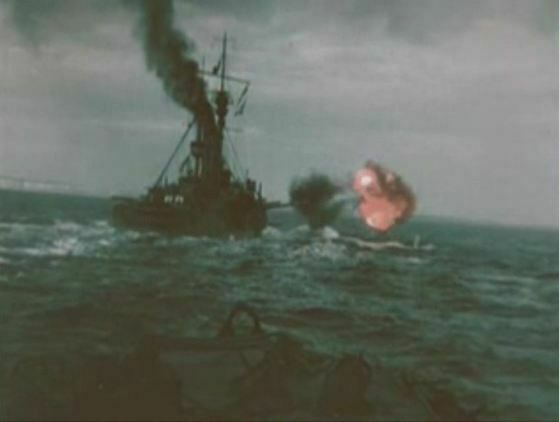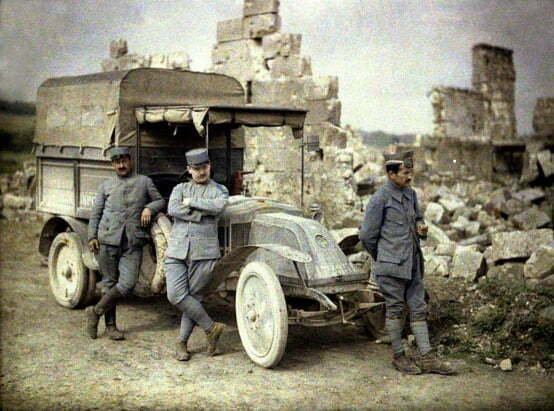
A new film, as yet untitled, made by Peter Jackson (of Lord of the Rings fame) and his company WingNut Films has just been announced. Commissioned by the UK World War I centenary art organisation 14-18 NOW, and scheduled to be premiered at the London Film Festival in November 2018, with cinema and school showings and a BBC One broadcast planned, it is clearly expected to make a great impact as it marks the end of the 1914-1918 centenary events. The film is described on the 14-18 NOW site as follows:
Building on Jackson’s extensive interest in and knowledge of the First World War, this exciting new film will use modern-day techniques such as colourisation to portray the Great War as never before, and promises to provide a 21st-century public with a unique new perspective on the 20th century’s most shocking conflict.
What is going on here? Colourisation of black-and-white film is not a new thing, of course. It was introduced in 1980s by studios with the hope of converting old film into more marketable commodities for generations who could only accept colour. The results were frequently garish, and the reactions from filmmakers and commentators was invariably hostile, objecting to the abuse of art and the ignorance of how the films has been originally composed (lighting, design, costume) for showing in black-and-white. There was nervousness over what would happen if ever someone decided to colourise Casablanca or other such classics. In the end, colourisation became a niche activity, derided by anyone who knew their film history, but still surviving on some bargain bin DVD releases and afternoon TV slots.
In 2003 there was a television series, World War I in Colour. Over six episodes it presented an entirely colourised film of the war, accompanying a standard narrative related by Kenneth Branagh. Aside from its garishness, there were criticisms from those who knew their military history and their film history. To begin with, in the First World War era, film was made on orthochromatic stock. Such stock was sensitive to green and blue, but lacked red sensitivity. Only with panchromatic stock, introduced in the 1920s (after earlier experiments) was sensitivity to all colours established. So the idea that by colourising a First World War film you were using the black-and-white record as a key to a hidden colour record was false. The authentic colour could not be digitally deduced from the monochrome. So it was that there were falsities of uniform colours, insignia, skin tones, skies and landscapes. It was a fantasy, the equivalent of a period colour postcard, or the artificially coloured films of that time, where colours were painted mechanically onto the film stock. Very pretty sometimes, but quite untrue.
There was some colour film made during the first few months of World War One, in the Kinemacolor process. There were some scenes taken of Belgian troop movements and the evacuation of Ghent and Ostend – footage that is now lost – and film of the British navy off Scapa Flow in 1915 for the documentary feature Britain Prepared, a few minutes of which do survive. This is what that colour looks like:

But the rest the First World War film archive, 99.9999% of it, is in black-and-white. That’s the historical reality. That is our inheritance.
There is an argument for the colourisation of footage from the First World War. One can say that the original film is, of course, not reality, but a reflection of reality. Overlaying it with colour is only a further treatment of that reflection of reality, a way of looking at the past rather than the pretence of being the past itself. One could argue that the original filmmakers would have chosen colour if they could (undoubtedly so), so that colourisation is only a belated response to their wishes. One could argue that Jackson’s film is a work in its own right, with the express purpose of communicating an idea of the immediacy and humanity of the war through means that speak to a young generation who know nothing of black-and-white film. The original films remain in black-and-white, to be consulted separately as the precious artefacts that they are. No damage has been done, and some good has been achieved.
Such arguments can be made, and the latter forms the basis of this new work. But it is a nonsense. Colourisation does not bring us closer to the past; it increases the gap between now and then. It does not enable immediacy; it creates difference. It makes the past record all the more distant for rejecting what is honest about it. Jackson has said in interview:
The results we have got are absolutely unbelievable. This footage looks like it was shot in the last week or two, with high definition cameras … It’s not the usual film of the First World War. The faces of the men just jump out at you. It’s the human beings that were actually there …
If we want to encourage a new generation to understand what the war meant – and of course this is a good thing – we should be inviting them to look at the films as they were made and through that effort to appreciate them for what they are, and what they meant in their time. It’s the effort that creates the understanding. Without that there is no true sympathy, only false sentiment. Film that looks like it was shot last week belongs only to last week.
Apparently not only has the Jackson film has been made with the blessing of the Imperial War Museum (home to the UK’s First World War film archive), but the IWM co-commissioned it. This seems hard to believe. To me, it is contrary to everything that film archiving is about. Yes, on some occasions archive film can and should be manipulated for particular ends. It need not always be treated reverently in its original form alone – that way elitism lies. But using it to show what it is not does more damage than good. If we want people to understand the past, we should not be colouring it.
Update: The film is called They Shall Not Grow Old.
Links:
- The press release for the Peter Jackson film, for which just the one still has been made public so far, is on the 14-18 NOW website
- There was almost no colour film of the First World War made, but quite a number of colour photographs survive, taken using the Autochrome process. There is a fine display of some on Slate.com. Here’s an example:

Thanks for this post Luke, I’ve been thinking and worrying about this since I read the press release. The IWM? Really? It smacks of gimmickry and not much else; hopefully I’m wrong.
I’d like to know more before casting aspersions, and of course we all need to see the film rather than judge from a still and press release quotes. It could be brilliantly done, and brilliance becomes its own justification.
Hi Luke, I’d love to know what you make of this film now that it’s been shown and seen. (Please do direct me to anything you’ve written since. I’m a bit behind with this film, but watched it on TV this evening – I dislike 3D.)
Hi Geoff,
I’ve seen the film now. I have to admit I was greatly disappointed. I had expected, after all the strong reviews and positive comments from some who know their subject, that I would see something that forced me to change my ideas. Instead I saw something characterised by unreality. The colour looks, as it indeed is, as something added on rather than growing out of the source material. It is palpably false. The absence of grain, the loss of resolution with the blown-up close-ups, even the fact that the entire war seems to have been conducted under sunshine and blue skies, all counted towards the unnatural feel, at least as it came across to me.
There were some sequences where the colour caused a jolt of surprise; at times it was useful (mostly the bloody scenes). But the monochrome that topped and tailed the film had a good deal more to show, and to tell, despite being shown at too fast a speed (presumably to accentuate the difference).
Instead what impressed me was the sound. What we have here is a great oral history production. The sound editing is superb; a monumental effort compiling extracts from all those interviews, with such character, variety and propulsion. Indeed, I would have preferred the whole thing to have had no pictures. They only obscure what is excellent about it.
The awkward question for myself is – would I have been convinced had the colour been better? But if so, convinced of what?
Thanks, Luke. I myself found the film very moving, but I too am not sure I needed the colour to be affected. It does feel unnatural and therefore ‘false’, but I became so engrossed by the ‘storytelling’ aspects – which are mainly to do with the aural narrative, of course – that I came to forget about that. Since I wasn’t expecting too much (indeed, I suppose I was half expecting to take against it), I was for the most part pleasantly surprised.
A variation on this post has been published in the April edition of Sight and Sound https://sightandsounddigital.bfi.org.uk
This press release has been issued by the BFI:
Peter Jackson’s First World War film They Shall Not Grow Old to World Premiere at LFF 2018
A special presentation of this unique film commissioned by 14-18 NOW and Imperial War Museums will take place on 16 October 2018 at BFI Southbank, with Peter Jackson in conversation.
The 62nd BFI London Film Festival in partnership with American Express® is delighted to announce that Peter Jackson’s First World War film, newly titled They Shall Not Grow Old, will be given its World Premiere as the Documentary Special Presentation at the BFI London Film Festival on 16 October, at BFI Southbank.
Trafalgar Releasing and the BFI London Film Festival are also pleased to confirm that the film will be simultaneously screened, in 2D and 3D to cinemas and special venues across the UK. Attended by the director Peter Jackson, the simulcast will include a special post screening Q&A with Jackson, hosted by film critic Mark Kermode.
The FIAF Code of Ethics (3rd ed) is rather clear on the responsibilities of its members in regards to their collections:
1.5. When restoring materials, archives will endeavour only to complete what is incomplete and to remove the accretions of time, wear, and misinformation. They will not seek to change or distort the nature of the original materials or the intentions of their creators.
1.6. When providing access to materials by programming, projection, or other means, archives will seek to achieve the closest possible approximation to the original viewing experience, paying particular attention (for example) to the appropriate speed and the correct aspect ratio.
1.7. The nature and rationale of any debatable decision relating to restoration or presentation of archive materials will be recorded and made available to any audience or researcher.
Perhaps Mark Kermode will include it in his questions.
I saw Peter Jackson’s “They Shall Not Grow Old” last night in a theater with great sound and a bright clear projection image. I know more about WW1 than most Yanks but I still found Jackson’s film moving. I’m sure 99% of people in the USA haven’t seen 3% of the clips in the film and just as few knew how truly horrendous the conditions were. This film makes all of that clear.
I found some elements particularly impressive. First, all the film was shown at the correct speed. This does a huge amount to humanize the people in the film. The corrections of contrast also add a lot to making the participants seem real.
Finally, I find the colorization to be a huge benefit. I cannot fathom why a person would say “Yes, monochrome is the way it was shot and the way it looks best”. This isn’t a “film school art project”. Monochrome wasn’t a choice. It a film that creates a connection with 100 year past events. Adding color has to have required many hours of time and cost to an already huge project and it was time well-spent. This film humanizes the suffering of ALL the participants by showing the plight of the British soldier. Color adds pathos that is utterly lost in monochrome. The fact that it may seem inaccurate or garish to some nit-pickers completely misses the point. In color, it is much, much closer to how it looked like at the time. I congratulate Jackson for his effort.
I’m trying hard to understand this argument, but honestly it makes no sense to me. If you want to understand the history of film technology, of course you should study the original, unedited footage. But this really has nothing to do with film archiving. No one is suggesting we get rid of the original and replace it. It’s great how many people are interested in watching this an other “upscaled” historical footage and it’s making people curious and thinking about history. So long as viewers are aware of the “artistic liberties” taken when colorizing I think it’s entirely a good thing. I’m sorry, but this really does just sound like elitism to me.
I echo many of Josh’s sentiments. If we should be inviting a new generation of people to inspect historical footage, wouldn’t it make sense to invite them using visual terminology they already understand? If anything, I see colorization as just another, perhaps more accessible, lens through which to view the past. McKernan really said it very well when he said the original film is not reality. It’s a lens to be interpreted. I can think of no way that viewing colorized film disincentivizes me from also viewing black and white film. In actuality it seems quite the opposite. I hate to compare it to introducing a friend to Doctor Who but it’s a lot like that. You’re going to loose people if you start in season one. You just are. However, if you start with David Tennant and eventually circle back around to season one, you tend to find more interested parties. Different people need different jumping off points for their interests.
PS. I just noticed that this article was written in 2018 but I’ve already typed out such a lovely comment. Best regards.
There has been renewed interest in this 2018 post after it was quoted in a piece by Thomas Nicholson, ‘YouTubers are upscaling the past to 4K. Historians want them to stop‘, for Wired.co.uk. The piece is chiefly concerned with the recent ‘upscaling’ of early films done by Denis Shiryaev on the Neural Love site. I rather admire this work, which is reasonably honest about how it has treated the originals, and is fun. Contrary to what the article’s title states, this historian does not want them to stop. I just want there to be better understanding, not least of the consequences.